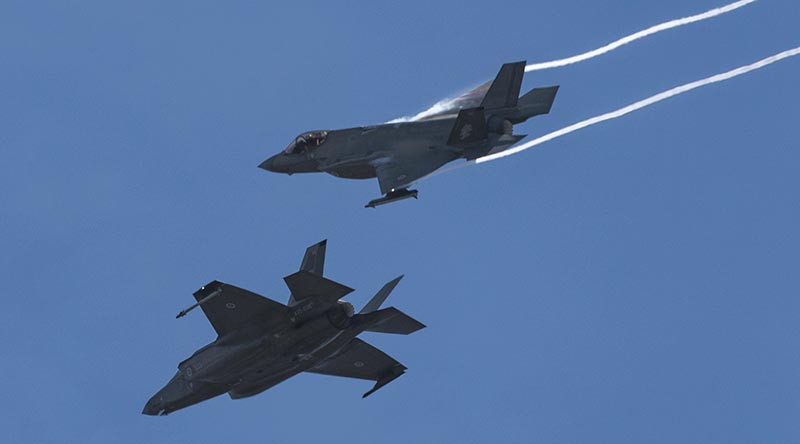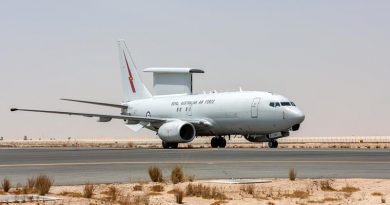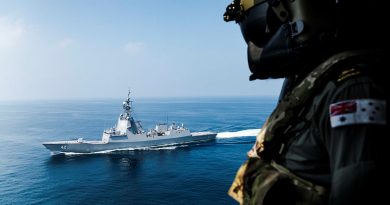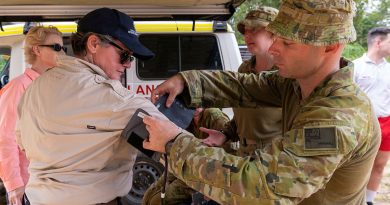Exercise Diamond Shield 24 produces more Aussie air defenders
Share the post "Exercise Diamond Shield 24 produces more Aussie air defenders"

The Royal Australian Air Force’s newest class of air warfare instructors faced three weeks of challenging air defence scenarios during Exercise Diamond Shield 24 on Australia’s east coast recently.
CAPTION: F-35A Lightning II aircraft A35-020 breaks away from A35-038 in readiness to land at RAAF Base Williamtown during Exercise Diamond Shield 24. Photo by Leading Aircraftman Kurt Lewis.
Held from RAAF Bases Williamtown and Amberley from March 11 to 28, the exercise involved 24-hour-a-day defence of Australia training in airspace from Brisbane to Jervis Bay, covering an area of more than 200,000 square kilometres.
During the exercise, the students were challenged with complex mission scenarios while flying F-35 Lightning II aircraft – but they were not without friends.
Flying alongside their fast-jet brethren was the RAAF’s E-7A Wedgetail airborne early warning and control aircraft plus KC-30A multi-role tankers.
Director of Exercise Diamond Shield 24 Group Captain Martin Parker said the exercise involved dynamic scenarios to defend Australia from attack.
“Exercise Diamond Shield 24 is defensive in nature and we give the course participants really wicked problems,” Group Captain Parker said.
“They come together to find the answers to these challenging scenarios and then they implement their solutions.
“It is effectively passing best practice from one generation to another while also giving them the environment to learn and thrive.”
Exercise Diamond Shield 24 forms part of the six-month-long Air Warfare Instructor Course (AWIC), which combines exercises with academic instruction and briefings on the ground.
The 2024 instalment of AWIC marks 70 years of air warfare training in Australia with the first fight combat instructor course completed in 1954.
“Our warfare instructor course has its origins from 1954 when Wing Commander Dick Cresswell took the lessons out of Korea where Australia lost 41 pilots and 54 out of our 90 aircraft,” Group Captain Parker said.
“He set out on the endeavour to resolve those issues and embed a culture and a course of excellence, which has permeated for 70 years.”
3 Control and Reporting Unit (3CRU) and the E-7A Wedgetail participated in the exercise to provide a live “big picture” of the battle space, providing students with mission-critical situational awareness.
3CRU provided effective and timely communications and intelligence from multiple locations along the east coast of Australia throughout the exercise.
The unit’s air battle managers and air surveillance operators used advanced electronic equipment to monitor the airspace to identify and analyse aircraft and surface vessels, with the information relayed to support fast-jet aircrew.
Air Battle Manager Flying Officer Daniel Avramovski said the exercise gave 3CRU the opportunity to see how their skills would be used in a tactical scenario.
“Over Diamond Shield, 3CRU integrated with other platforms and systems such as the E-7A, to provide persistent air battle management and a surveillance picture that acted as a conduit for information between strategic, operational and tactical stakeholders,” Flying Officer Avramovski said.
“As a weapons director, I provided tactical information about the air picture over the radio to fighter aircraft to enable them to make the best decisions going into the air battle.”
The crew on board the Wedgetail delivered intelligence support from the air as the exercise aimed to combine the people, platforms and practices that allow the Royal Australian Air Force to deliver world-class strike capabilities.
Exercise Director Group Captain Martin Parker said it was important that a range of RAAF assets participated.
“Contemporary threat scenarios and the problem sets that we give to the students of the course are wicked problems.
“They are unable to be solved by any one capability,” Group Captain Parker said.
“This requires teamwork across all of the air components capabilities to bring best effect, to mitigate each other’s weaknesses and amplify our strengths.”
CONTACT believes RAAF is deliberately dropping ‘Royal Australian’ from its name – despite Defence assuring us it isn’t true. Campaigning against this name-change-by-stealth, CONTACT has appropriately ‘repaired’ this official story. See here for more details
.
.

.
.
Share the post "Exercise Diamond Shield 24 produces more Aussie air defenders"





